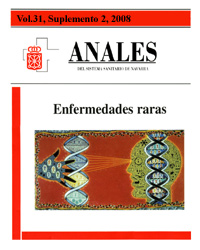Talla baja y enfermedades raras
Palabras clave:
Baja talla, Enfermedad raraResumen
La baja talla constituye el primer motivo de consulta en endocrinología pediátrica. En un alto porcentaje su etiología es clara y obedece fundamentalmente a variantes de normalidad. Sin embargo, en aproximadamente un 20% esta baja talla es patológica y obliga a estudios exhaustivos. La asociación de enfermedades raras (ER) con talla baja es altamente frecuente. En este trabajo repasamos las etiologías de la baja talla en enfermedades raras, describiendo: – las formas genéticas de la hormona de crecimiento (GH) bien sean aisladas o asociadas a malformaciones de la línea media u otras. – aquellas de gran importancia por su repercusión clínica como el Síndrome de Turner, Síndrome de Noonan y el Síndrome de Willi-Prader. – Las frecuentes displasias óseas, con alteración genética en algunos casos para el gen SHOX, situado en el brazo corto del cromosoma Xp. La importancia de estos diagnósticos radica en la posibilidad de hacer un tratamiento precoz y eficaz, en algunos de ellos, con GH. En conclusión, el diagnóstico de enfermedades raras con baja talla es un reto actual y habitual en endocrinología pediátrica por los grandes avances de la genética molecular y la posibilidad de tratamiento en algunas de ellas. Implica siempre un abordaje multidisciplinario por la asociación frecuente de patología que presenta y a su vez, ofrece la posibilidad de realizar el oportuno consejo genético.Descargas
Descargas
Publicado
Cómo citar
Número
Sección
Licencia
La revista Anales del Sistema Sanitario de Navarra es publicada por el Departamento de Salud del Gobierno de Navarra (España), quien conserva los derechos patrimoniales (copyright ) sobre el artículo publicado y favorece y permite la difusión del mismo bajo licencia Creative Commons Reconocimiento-CompartirIgual 4.0 Internacional (CC BY-SA 4.0). Esta licencia permite copiar, usar, difundir, transmitir y exponer públicamente el artículo, siempre que siempre que se cite la autoría y la publicación inicial en Anales del Sistema Sanitario de Navarra, y se distinga la existencia de esta licencia de uso.








